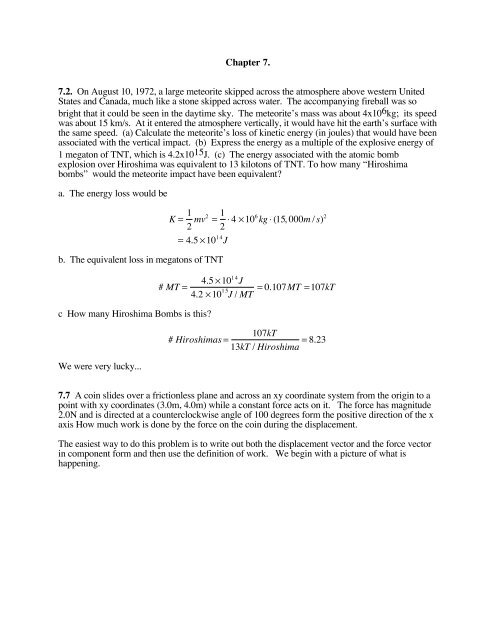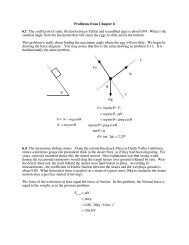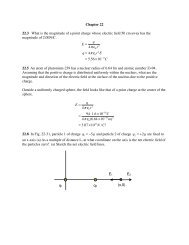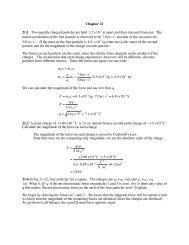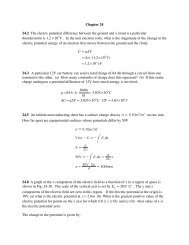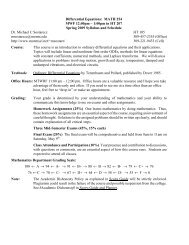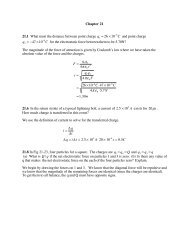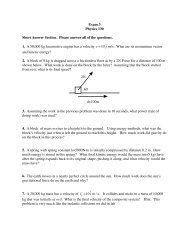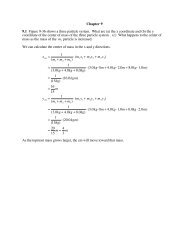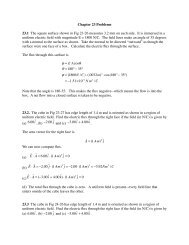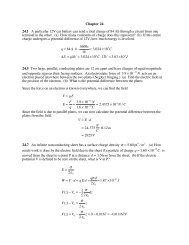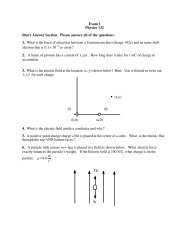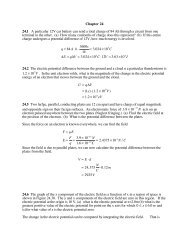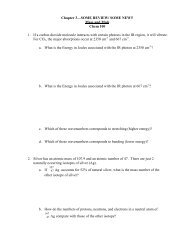Chapter 7. 7.2. On August 10, 1972, a large meteorite skipped ...
Chapter 7. 7.2. On August 10, 1972, a large meteorite skipped ...
Chapter 7. 7.2. On August 10, 1972, a large meteorite skipped ...
You also want an ePaper? Increase the reach of your titles
YUMPU automatically turns print PDFs into web optimized ePapers that Google loves.
<strong>Chapter</strong> <strong>7.</strong><br />
<strong>7.</strong>2. <strong>On</strong> <strong>August</strong> <strong>10</strong>, <strong>1972</strong>, a <strong>large</strong> <strong>meteorite</strong> <strong>skipped</strong> across the atmosphere above western United<br />
States and Canada, much like a stone <strong>skipped</strong> across water. The accompanying fireball was so<br />
bright that it could be seen in the daytime sky. The <strong>meteorite</strong>’s mass was about 4x<strong>10</strong> 6 kg; its speed<br />
was about 15 km/s. At it entered the atmosphere vertically, it would have hit the earth’s surface with<br />
the same speed. (a) Calculate the <strong>meteorite</strong>’s loss of kinetic energy (in joules) that would have been<br />
associated with the vertical impact. (b) Express the energy as a multiple of the explosive energy of<br />
1 megaton of TNT, which is 4.2x<strong>10</strong> 15 J. (c) The energy associated with the atomic bomb<br />
explosion over Hiroshima was equivalent to 13 kilotons of TNT. To how many “Hiroshima<br />
bombs” would the <strong>meteorite</strong> impact have been equivalent?<br />
a. The energy loss would be<br />
K = 1 2 mv2 = 1 2 ⋅ 4 ×<strong>10</strong>6 kg ⋅ (15, 000m / s) 2<br />
= 4.5 ×<strong>10</strong> 14 J<br />
b. The equivalent loss in megatons of TNT<br />
# MT =<br />
c How many Hiroshima Bombs is this?<br />
We were very lucky...<br />
4.5 ×<strong>10</strong> 14 J<br />
4.2 ×<strong>10</strong> 15 J / MT<br />
= 0.<strong>10</strong>7MT =<strong>10</strong>7kT<br />
<strong>10</strong>7kT<br />
# Hiroshimas =<br />
13kT / Hiroshima = 8.23<br />
<strong>7.</strong>7 A coin slides over a frictionless plane and across an xy coordinate system from the origin to a<br />
point with xy coordinates (3.0m, 4.0m) while a constant force acts on it. The force has magnitude<br />
2.0N and is directed at a counterclockwise angle of <strong>10</strong>0 degrees form the positive direction of the x<br />
axis How much work is done by the force on the coin during the displacement.<br />
The easiest way to do this problem is to write out both the displacement vector and the force vector<br />
in component form and then use the definition of work. We begin with a picture of what is<br />
happening.
y<br />
(3,4)<br />
F<br />
d<br />
<strong>10</strong>0<br />
x<br />
<br />
d = 3ˆ i + 4 ˆ j<br />
<br />
F = 2cos<strong>10</strong>0°ˆ i + 2sin<strong>10</strong>0° ˆ j<br />
W = F <br />
⋅ d<br />
<br />
= 3⋅2cos<strong>10</strong>0° + 4 ⋅ 2sin<strong>10</strong>0°<br />
= 6.84J<br />
= 4.52J<br />
<strong>7.</strong><strong>10</strong> An 8.0 kg object is moving in the positive direction of an x axis. When it passes through<br />
x=0, a constant force directed along the axis begins to ac on it. Figure <strong>7.</strong>27 give its Kinetic energy<br />
K verses position x as it moves form x-0 to x=5m. The force continues to act. What is v when<br />
the object moves back through x=-3.<br />
K<br />
30J<br />
5 x (m)<br />
The decreasing kinetic energy indicates that the work done by the force is negative. This means that<br />
for our right (+) moving mass, the force must be directed to the left. We can find the force by<br />
examining the change in kinetic energy over the distance x=0 to x=5. For this case, we can write<br />
(since we know that the force is opposite the displacement).
ΔK = F <br />
⋅ d<br />
<br />
= Fd cos180<br />
= −Fd<br />
0 − 30J = −F ⋅ 5m<br />
F = 6N<br />
Now that we know the force, we can compute the work done between 0 and -3. In this case, the<br />
motion is to the left and the force is to the left, so the angle between force and displacement is 0<br />
degrees.<br />
ΔK =<br />
F <br />
⋅ d<br />
<br />
= Fd cos0<br />
= Fd<br />
K f<br />
− 30J = 6N ⋅ 3m<br />
K f<br />
− 30J =18J<br />
K f<br />
= 48J<br />
1<br />
2 mv 2 f<br />
= 48J<br />
v f<br />
=<br />
2 ⋅ 48J<br />
m<br />
= 2 ⋅ 48J<br />
8kg<br />
= 3.46m / s<br />
<strong>7.</strong>13 Figure 7-29 shows three forces applied to a greased trunk that moves leftward by 3m over a a<br />
frictionless floor. The force magnitudes are F1=5.00N, F2=9.00N, and F3=3.00N. During the<br />
displacement, (a) what is the net work done on the trunk by the three forces and (b) does the<br />
kinetic energy of the trunk increase or decrease?<br />
Since there is no motion in the vertical direction, there is no work done by forces and components<br />
of forces in that direction. We need only concern ourselves with the horizontal motion<br />
F net− x<br />
= F 2<br />
cos60 − F 1<br />
= 9.00N ⋅ cos60 − 5.00N<br />
= −0.5N<br />
The net force is to the left. This is in the same direction as the motion. The work done is therefore<br />
positive.<br />
W = F net− x<br />
d<br />
= 0.5N ⋅3m<br />
= 1.5J<br />
The work done on the trunk is positive, so the kinetic energy increases.
<strong>7.</strong>18 In Fig. 7-31, a horizontal force F a<br />
of magnitude 20.0 N is applied to a 3.00 kg psychology<br />
book as the book slides a distance d = 0.500m up a frictionless ramp at angle θ = 30° . (a) During<br />
the displacement, what is the net work done on the book by F a<br />
, the gravitation force on the book<br />
and the normal force on the book? (b) If the book has zero kinetic energy at the start of the<br />
displacement , what is its speed at the end of the displacement.<br />
We begin with a drawing<br />
N<br />
d<br />
θ<br />
Fa<br />
mg<br />
We can calculate the work done by each force<br />
W N<br />
= N ⋅ d = Nd cos90° = 0<br />
W a<br />
= F a<br />
⋅d = F a<br />
d cosθ = 20N ⋅ 0.5m⋅ cos 30° = 8.66J<br />
W mg<br />
= mg ⋅ d = mgd cos(90 + θ) = 3.0kg ⋅ 9.8m / s 2 ⋅ 0.5m⋅ cos(90 + 30) = −<strong>7.</strong>35J<br />
To find the final speed, we can use the work to find the change in kinetic energy<br />
W net<br />
= W N<br />
+ W a<br />
+W mg<br />
= 1.31J<br />
W net<br />
= ΔKE =<br />
1 2 mv 2 f<br />
− 1 2 mv i2<br />
= 1 2 mv f<br />
2<br />
− 0<br />
v f<br />
=<br />
2W net<br />
m<br />
= 0.9345m / s
<strong>7.</strong>22 A cave rescue team lifts an injured spelunker directly upward and out of a sinkhole by means<br />
of a motor driven cable. The lift is performed in three stages, each requiring a vertical distance of<br />
<strong>10</strong>.0 m: (a) initially stationary spelunker is accelerated to a speed of 5.00 m/s; (b) he is then lifted<br />
at the constant speed of 5.00 m/s; (c) finally he is decelerated to zero speed. How much work is<br />
done on the 80 kg rescuee by the force lifting him during each stage.<br />
Two forces act on the rescuee: Tension in the cable and weight.<br />
T<br />
mg<br />
We are interested in finding the work done by the tension. We will do this by calculating the net<br />
work done first.<br />
Stage I. (final velocity = 5m/s, initial velocity = 0m/s)<br />
W net<br />
= ΔKE = 1 2 mv f 2 − 0 =<strong>10</strong>00J<br />
W mg<br />
= −mgd = −80kg ⋅ 9.8 m ⋅<strong>10</strong>m = −7840J<br />
2<br />
s<br />
W net<br />
= W mg<br />
+ W T<br />
W T<br />
= W net<br />
− W mg<br />
= <strong>10</strong>00J − (−7840J ) = 8840J<br />
Stage II (final velocity = 5m/s, initial velocity = 5 m/s)<br />
W net<br />
= ΔKE =<br />
1 2 mv 2 f<br />
− 1 2 mv 2 i<br />
= 0J<br />
W mg<br />
= −mgd = −80kg ⋅ 9.8 m ⋅<strong>10</strong>m = −7840J<br />
2<br />
s<br />
W net<br />
= W mg<br />
+ W T<br />
W T<br />
= W net<br />
− W mg<br />
= 0J − (−7840J ) = 7840J
Stage II (final velocity = 5m/s, initial velocity = 5 m/s)<br />
W net<br />
= ΔKE =<br />
1 2 mv 2 f<br />
− 1 2 mv 2 i<br />
= 0J<br />
W mg<br />
= −mgd = −80kg ⋅ 9.8 m ⋅<strong>10</strong>m = −7840J<br />
2<br />
s<br />
W net<br />
= W mg<br />
+ W T<br />
W T<br />
= W net<br />
− W mg<br />
= 0J − (−7840J ) = 7840J<br />
Stage III (final velocity = 0m/s, initial velocity = 5 m/s)<br />
W net<br />
= ΔKE =<br />
1 2 mv 2 f<br />
− 1 2 mv 2 i<br />
= 0J − <strong>10</strong>00J<br />
W mg<br />
= −mgd = −80kg ⋅ 9.8 m ⋅<strong>10</strong>m = −7840J<br />
2<br />
s<br />
W net<br />
= W mg<br />
+ W T<br />
W T<br />
= W net<br />
− W mg<br />
= −<strong>10</strong>00J − (−7840J ) = 6840J<br />
<strong>7.</strong>24 During spring semester at MIT, residents of the parallel buildings of the East Campus dorms<br />
battle one another with <strong>large</strong> catapults that are made with surgical hose mounted on a window<br />
frame. A balloon filled with dyed water is placed in a pouch attached to the hose, which is stretched<br />
through the width of the room. Assume that the stretching of the hose obeys Hooke’s law with a<br />
spring constant of <strong>10</strong>0 N/m. If the hose is stretched by 5.00 m and then released, how much work<br />
does the force from the hose do on the balloon in the pouched by the time the hose reaches its<br />
relaxed length.<br />
The magnitude of the work is<br />
W = 1 2 k x2 = 1 2 ⋅<strong>10</strong>0N / m ⋅(5.00m)2 = 1250J<br />
The work done is positive because the force acts in the direction of the motion.<br />
<strong>7.</strong>50 A 250 g block is dropped onto a vertical spring with spring constant k=2.5N/cm. the block<br />
becomes attached to the spring and the spring compresses 12 cm before momentarily stopping.<br />
While the spring is being compressed, what work is done on the block (a) by its weight, and (b) by<br />
the spring force? (c) What is the speed of the block just before it hits the spring? (d) If the speed<br />
is doubled,what is the maximum compression of the spring.<br />
a. The work done by weight is positive. The force is downward and so is the motion.<br />
W w<br />
= mgy = 0.25kg ⋅9.8m / s 2 ⋅ 0.12m<br />
= 0.294J<br />
b) The work done by the spring is negative. The force is upward but the motion is downward.
k = 2.5N<br />
cm ⋅<strong>10</strong>0cm 1m<br />
= 250N / m<br />
W s<br />
= − 1 2 k x2 = − 1 ⋅250N / m ⋅(0.12m)2<br />
2<br />
= −1.8J<br />
c) The net work done equals the change in Kinetic energy.<br />
W net<br />
= W mg<br />
+ W s<br />
= 0.294J −1.8J = −1.506J<br />
K f<br />
− K i<br />
= W net<br />
0 − 1 2 mv 2 i<br />
= W net<br />
v i<br />
=<br />
−2W net<br />
m<br />
=<br />
−2⋅ (−1.506J)<br />
0.25<br />
= 3.47m / s<br />
d) Use work to determine the final compression. The velocity is twice the value found in part c.<br />
We choose the negative solution, since we know that the mass drops below the zero starting value...<br />
v i<br />
= 2 ⋅ 3.47m / s = 6.94m / s<br />
W net<br />
= ΔK = 0 − 1 2 mv 2<br />
i<br />
W net<br />
= mgy + 1 2 ky2<br />
mgy − 1 2 ky2 = − 1 2 mv 2<br />
i<br />
1<br />
2 ky2 − mgy − 1 2 mv 2 i<br />
= 0<br />
y =<br />
+mg ± (mg) 2 − 4 ⋅ 1 2 k ⋅ (− 1 2 mv i2 )<br />
2 ⋅( 1 2 k)<br />
= +mg ± (mg)2 + kmv i 2 )<br />
k<br />
= +0.25kg ⋅9.8m / s2 ± (0.25kg ⋅ 9.8m / s 2 ) 2 + 250N / m ⋅0.25kg ⋅(6.94m / s) 2<br />
250N / m<br />
= −0.2099m


